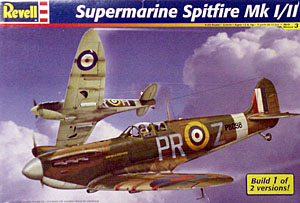Revell's 1/32 Supermarine Spitfire Mk. I/II | | History It's a Spitfire. Early one, too. You know, Battle of Britain and all that. 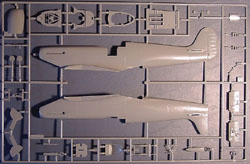 The Kit The Kit
If you've cringed on seeing this kit at the local hobby shop, thinking it's the old Revell kit from the 1960s, well, you're wrong. This is in fact a reboxing of the Hasegawa Mk. V kit, with additional parts to make the Mk. I/II. These extra parts are in plastic form, not resin as was initially rumored. So what's in the box? You get a total of four trees of gray plastic, one of clear, and a large decal sheet. Three of the trees (including the clear parts) are from the original Hasegawa kit, while the remaining two are specifically for the Mk. I/II. If you're familiar with the Hasegawa kit, the interior is the same, with the cockpit made up of no less than 23 parts. Even with all of these parts, though, the interior could probably use some additional work. I wouldn't be surprised to see some resin 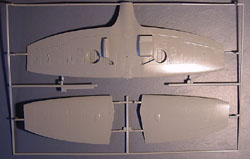 aftermarket sets in the near future to help in this area. If you just want a quick OOB build, though, the kit parts will definitely be more than acceptable and will respond to some careful painting quite well. In addition to the regular interior, the kit comes with a pilot figure, made up of four pieces. aftermarket sets in the near future to help in this area. If you just want a quick OOB build, though, the kit parts will definitely be more than acceptable and will respond to some careful painting quite well. In addition to the regular interior, the kit comes with a pilot figure, made up of four pieces. The fuselage halves are the same as in the original Mk. V kit, which means that they have very petite raised panel lines. The vertical fin is included with the fuselage, but the lower nose chin is separate. This is for the separate parts in the Mk. V to make up the desert type with the Volkes filter. The carburetor scoop is also separate, finishing up the fuselage assembly. 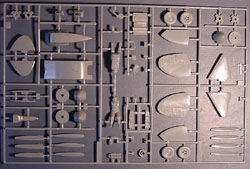 The wings are new from the original Hasegawa Mk. V release, and the most obvious difference is the panel lines. These are very finely recessed and will be a very noticeable contrast to the raised panels on the fuselage. With this in mind it would probably be best to rescribe the fuselage panel lines to match. The wingtips are separate, with three different examples, only one of which is appropriate for the Mk. I/II. Toss the rest in the spares box for some future project (you'll be doing that with quite a few parts in this kit). The tailplanes are original Hasegawa. The wings are new from the original Hasegawa Mk. V release, and the most obvious difference is the panel lines. These are very finely recessed and will be a very noticeable contrast to the raised panels on the fuselage. With this in mind it would probably be best to rescribe the fuselage panel lines to match. The wingtips are separate, with three different examples, only one of which is appropriate for the Mk. I/II. Toss the rest in the spares box for some future project (you'll be doing that with quite a few parts in this kit). The tailplanes are original Hasegawa.
New to the Mk. I/II release is the propeller. Actually this is just the propeller blades, and that only for the Mk. I version. The Mk. II version uses parts that were originally in the Hasegawa Mk. V kit. In fact, between all the kit parts you have a total of thirteen separate propeller blades, resulting in your spares box filling up rather quickly. There's a new spinner provided for the Mk. II, while the Mk. I spinner is from the original Hasegawa kit. There's also new exhaust stubs provided, allowing you to relegate the other ones to the spares box (I can't wait to see what's built up from all these leftover parts!). 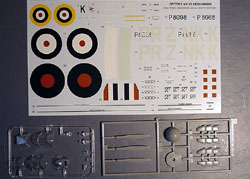 The decals provided in the kit offer a pair of Spitfires, one Mk. Ia and one Mk. II. The Mk. Ia is from No. 609 'West Riding' Squadron flying out of Middle Wallop in September 1940. Camouflaged in dark earth and dark green over sky, this plane has the phrase 'Enfield Spitfire' on the fuselage just ahead of the windscreen. The Mk. II is from No. 118 (F) Squadron, flown by Pilot Officer A.S.C. Lumsden in 1941. Also camouflaged in dark earth and dark green over sky, this plane has 'Borough of Lambeth' on the nose in front of the windscreen and 'Bette' on the cockpit hatches. The decal sheet also includes ample stenciling as well. The decals provided in the kit offer a pair of Spitfires, one Mk. Ia and one Mk. II. The Mk. Ia is from No. 609 'West Riding' Squadron flying out of Middle Wallop in September 1940. Camouflaged in dark earth and dark green over sky, this plane has the phrase 'Enfield Spitfire' on the fuselage just ahead of the windscreen. The Mk. II is from No. 118 (F) Squadron, flown by Pilot Officer A.S.C. Lumsden in 1941. Also camouflaged in dark earth and dark green over sky, this plane has 'Borough of Lambeth' on the nose in front of the windscreen and 'Bette' on the cockpit hatches. The decal sheet also includes ample stenciling as well.
Conclusion If you want to build a 1/32 Spitfire, this is the kit you'll want to get, at least for a Mk. I/II. You'll end up with quite a few parts in the spares box as well as a nice looking Spitfire when you're done. With some extra detailing you will easily end up with a contest winner. Our thanks to Revell for the review sample. | 

 




|
